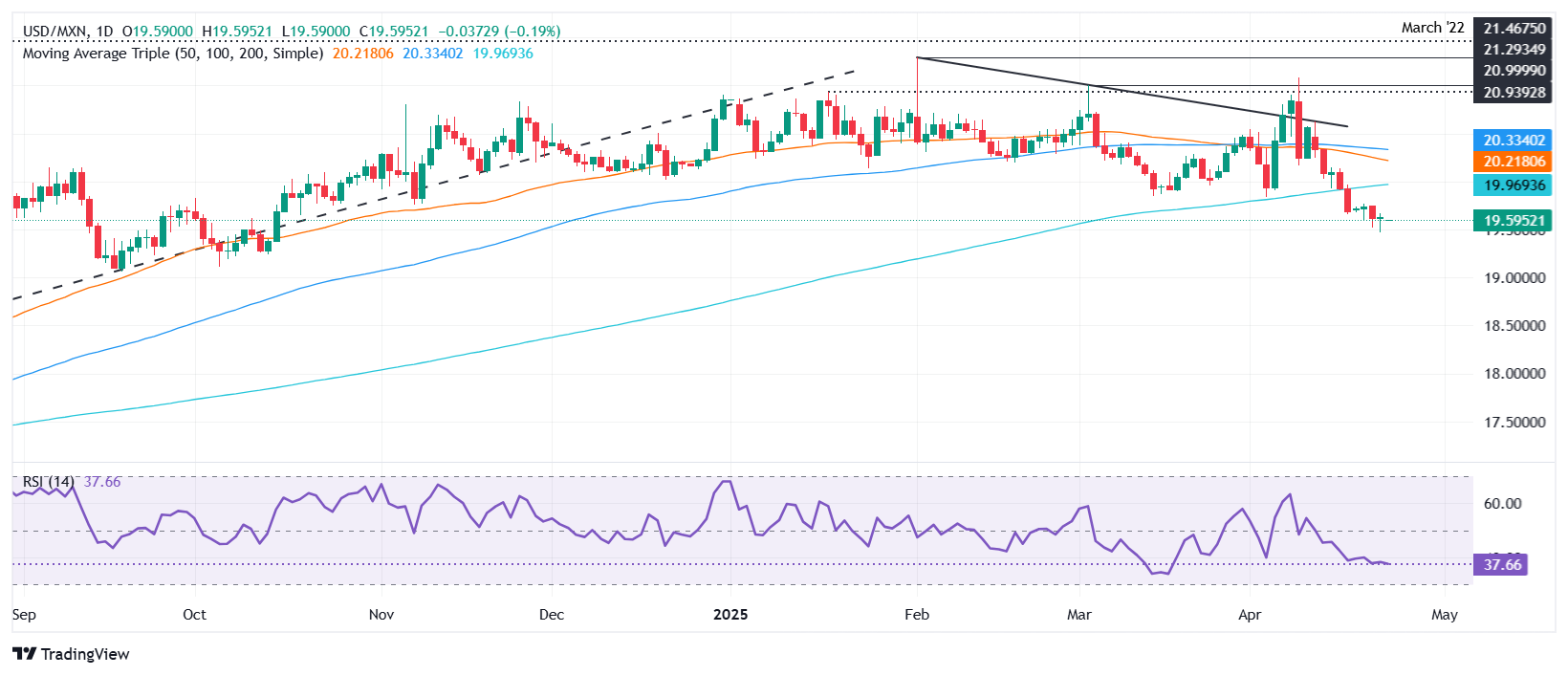- The Mexican weight can be seen while the USD/MXN falls to 19.57, the market anticipates another cut of 50 basic points of Banxico.
- Inflation in Mexico exceeds estimates but is maintained within the target range of Banxico.
- Citi’s survey shows that most economists expect a 50 basic points cut on May 15.
- Trump selective tariffs increase commercial risks but exclude Mexico – now.
The Mexican peso registered modest profits against the US dollar on Thursday due to the general weakness of the latter, despite the fact that inflation in Mexico was slightly higher than expected. At the time of writing, the USD/MXN trades 19.57 after reaching a daily maximum of 19.63.
The annual inflation of Mexico exceeded estimates in April, however, prices remained within the inflation objective of 2% to 4% of the Bank of Mexico (Banxico). Although prices increased, it is projected that Banxico will continue cutting rates at 50 basic points at the May meeting, which would be its third reduction in that size, after four consecutive cuts of 25 basic points since mid -2024.
In his latest expectations survey, Citi Mexico revealed that 36 economists surveyed expect the Central Bank to cut rates on May 15.
The tariffs of US President Donald Trump on Mexico’s, steel and aluminum exports of Mexico could further damage the country’s manufacturing base. However, some exporters felt relieved that Trump applied tariffs to most US business partners but kept Mexico out of the list.
Mexican president Claudia Sheinbaum has said she wants to reach an agreement with Trump, but failed to close a treatment in a phone call with him last week.
In the economic agenda of Mexico, operators prepare for the publication of economic activity data.
What moves the market today: the Mexican weight is not affected by the Dovish posture of Banxico
- The divergence between Banxico and the Fed favors a greater increase in the USD/MXN. The Banxico Governing Council expressed its decision to continue flexible politics. On the contrary, the Fed is considered cautious, since some officials have shown concerns about a reactivation of tariff -driven inflation.
- Inflation in the middle of the month in April in Mexico, 3.96% year -on -year accelerated, above 3.78% estimates. The underlying prices jumped from 3.56% to 3.90% year -on -year. Both figures remained within the 3% objective of Banxico more or less 1%.
- Retail sales in February were lower than expected, showing the ongoing economic slowdown, according to the National Institute of Statistics and Geography.
- The CITI Mexico expectations survey shows that economists expect Banxico to cut their rate at 50 basic points at the May meeting. For the whole year, they project that the main reference rate ends about 7.75%.
- As for the USD/MXN exchange rate, private analysts see the exotic pair ending at 20.93, above 20.90. It is projected that inflation in 2025 ends at 3.78% with underlying figures at 3.80%, mostly aligned with the previous survey.
- Mexico’s economy is expected to grow 0.2% in 2025, below 0.3% projected in the previous survey.
Technical perspective of the USD/MXN: The Mexican weight remains bullish while the USD/MXN is maintained below the 200 -day SMA
The bassist trend of the USD/MXN remains intact, but it seems that the vendors are taking a breath. They failed to drag the exchange rate below the minimum of April 23, 19.46. A daily closure below 19.50 could expose the minimum of the year to date (YTD), followed by the psychological figure of 19.00.
If buyers want to push up prices, they must recover the 200 -day SMA in 19.92, followed by the 20.00 figure. A rupture of this last will expose the confluence of the maximum of April 14 and the 50-day SMA about 20.25-20.29 before trying the 100-day SMA in 20.33.

Mexican weight FAQS
The Mexican weight (MXN) is the most commercialized currency among its Latin American peers. Its value is widely determined by the performance of the Mexican economy, the country’s central bank policy, the amount of foreign investment in the country and even remittance levels sent by Mexicans living abroad, particularly in the United States. Geopolitical trends can also affect MXN: for example, the Nearshoring process (or the decision of some companies to relocate the manufacturing capacity and supply chains closer to their countries of origin) is also considered a catalyst for the Mexican currency, since the country is considered a key manufacturing center in the American continent. Another catalyst for MXN is oil prices, since Mexico is a key exporter of the raw material.
The main objective of the Central Bank of Mexico, also known as Banxico, is to maintain inflation at low and stable levels (in or close to its 3%target, the midpoint of a tolerance band between 2%and 4%). To do this, the bank establishes an adequate level of interest rates. When inflation is too high, Banxico will try to control it by raising interest rates, which makes the indebtedness of homes and companies more cooling, thus cooling the demand and the economy in general. The highest interest rates are generally positive for Mexican weight (MXN), since they lead to higher yields, which makes the country a more attractive place for investors. On the contrary, lower interest rates tend to weaken the MXN.
The publication of macroeconomic data is key to evaluating the state of the economy and can have an impact on the valuation of the Mexican weight (MXN). A strong Mexican economy, based on high economic growth, low unemployment and high confidence is good for MXN. Not only attracts more foreign investment, but it can encourage the Bank of Mexico (Banxico) to increase interest rates, particularly if this fortress is accompanied by high inflation. However, if the economic data is weak, the MXN is likely to depreciate.
As an emerging market currency, the Mexican weight (MXN) tends to rise for periods of risk, or when investors perceive that the general market risks are low and, therefore, are eager to participate in investments that carry a higher risk. On the contrary, the MXN tends to weaken at times of market turbulence or economic uncertainty, since investors tend to sell higher risk assets and flee to the most stable safe shelters.
Source: Fx Street
I am Joshua Winder, a senior-level journalist and editor at World Stock Market. I specialize in covering news related to the stock market and economic trends. With more than 8 years of experience in this field, I have become an expert in financial reporting.







